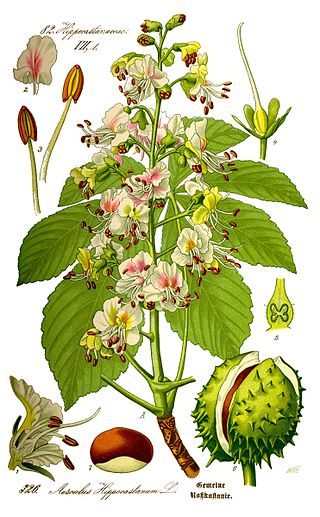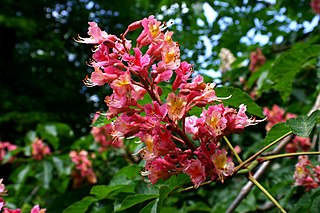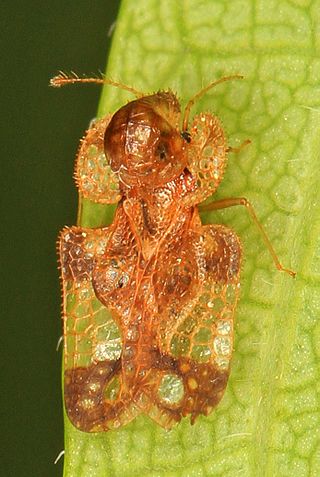
Aesculus pavia, known as red buckeye or firecracker plant, is a species of deciduous flowering plant. The small tree or shrub is native to the southern and eastern parts of the United States, found from Illinois to Virginia in the north and from Texas to Florida in the south. It is hardy far to the north of its native range, with successful cultivation poleward to Arboretum Mustila in Finland.

The genus Aesculus, with species called buckeye and horse chestnut, comprises 13–19 species of flowering plants in the family Sapindaceae. They are trees and shrubs native to the temperate Northern Hemisphere, with six species native to North America and seven to 13 species native to Eurasia. Several hybrids occur. Aesculus exhibits a classical Arcto-Tertiary distribution.

The Kentucky River Palisades are a series of steep, scenic gorges and limestone outcroppings that stretch for approximately 100 mi (160 km), along the Kentucky River in central Kentucky in the United States.

Aesculus hippocastanum, the horse chestnut, is a species of flowering plant in the maple, soapberry and lychee family Sapindaceae. It is a large, deciduous, synoecious (hermaphroditic-flowered) tree. It is also called horse-chestnut, European horsechestnut, buckeye, and conker tree. It is not to be confused with the Spanish chestnut, Castanea sativa, which is a tree in another family, Fagaceae.

Aesculus glabra, commonly known as Ohio buckeye, is a species of tree in the soapberry family (Sapindaceae) native to North America.

The Modoc Plateau lies in the northeast corner of California as well as parts of Oregon and Nevada. Nearly 1,000,000 acres (400,000 ha) of the Modoc National Forest are on the plateau between the Medicine Lake Highlands in the west and the Warner Mountains in the east.

Aesculus flava, also known commonly as the common buckeye, the sweet buckeye, and the yellow buckeye, is a species of deciduous tree in the subfamily Hippocastanoideae of the family Sapindaceae. The species is native to the Ohio Valley and Appalachian Mountains of the Eastern United States. It grows in mesophytic forest or floodplains, generally in acid to circumneutral soil, reaching a height of 20m to 48m.

The Dawes Arboretum is a nonprofit arboretum located in Newark, Ohio. It includes nearly 2,000 acres (8 km2) of plant collections, gardens and natural areas. The site includes approximately 12 miles (19 km) of hiking trails and roadways for a four-mile (6 km) driving tour.

Aesculin, also called æsculin or esculin, is a coumarin glucoside that naturally occurs in the trees horse chestnut, California buckeye, prickly box, and daphnin. It is also found in dandelion coffee.

The Buckeye is an American breed of chicken. It was created in Ohio in the late nineteenth century by Nettie Metcalf. The color of its plumage was intended to resemble the color of the seeds of Aesculus glabra, the Ohio Buckeye plant for which the state is called the 'Buckeye State'.

Aesculus × carnea, or red horse-chestnut, is a medium-sized tree, an artificial hybrid between A. pavia and A. hippocastanum (horse-chestnut). Its origin uncertain, probably appearing in Germany before 1820. It is a popular tree in large gardens and parks.

Aesculus sylvatica, the painted buckeye, is a species of shrub. The species has five leaflets that are 4.5 to 6 inches long and 1.5 to 2.5 inches wide. The flowers are yellow and occasionally have red also. The species have dry fruit and brown, scaly bark. The species is commonly found in forests and along stream banks. The shrub is poisonous, as are its seeds.
Bleeding canker of horse chestnut is a common canker of horse chestnut trees that is known to be caused by infection with several different pathogens.

Corythucha is a large genus of lace bug in the family Tingidae that is primarily distributed in the New World, especially North America. The genus includes pest species such as the “cotton or bean lace bug" as well as species that provide maternal care, such as C. hewitti (Drake)

Corythucha ciliata, the sycamore lace bug, is a species of lace bug in the family Tingidae that is associated with sycamore trees.

Corythucha gossypii, the cotton lace bug or bean lace bug, is a species of lace bug in the family Tingidae that is associated with cotton and a number of other host plants.

Aesculus parryi, known as the Parry buckeye or Baja California buckeye, is a species of shrub or small tree in the genus Aesculus. It is native to Mexico, specifically northwest Baja California.















